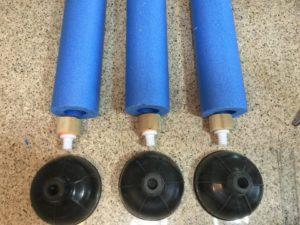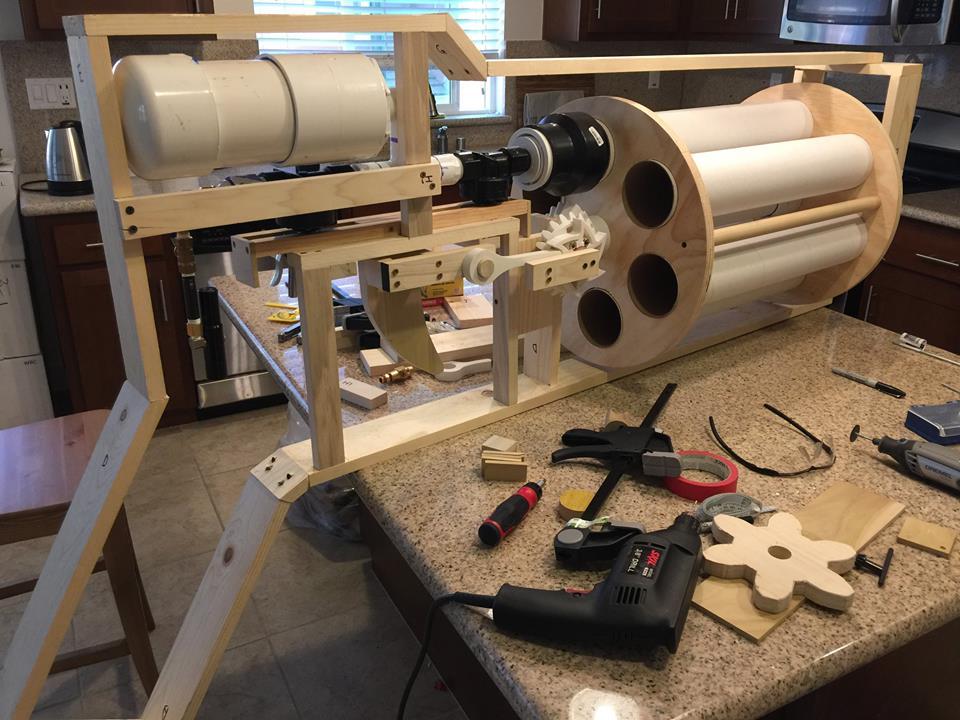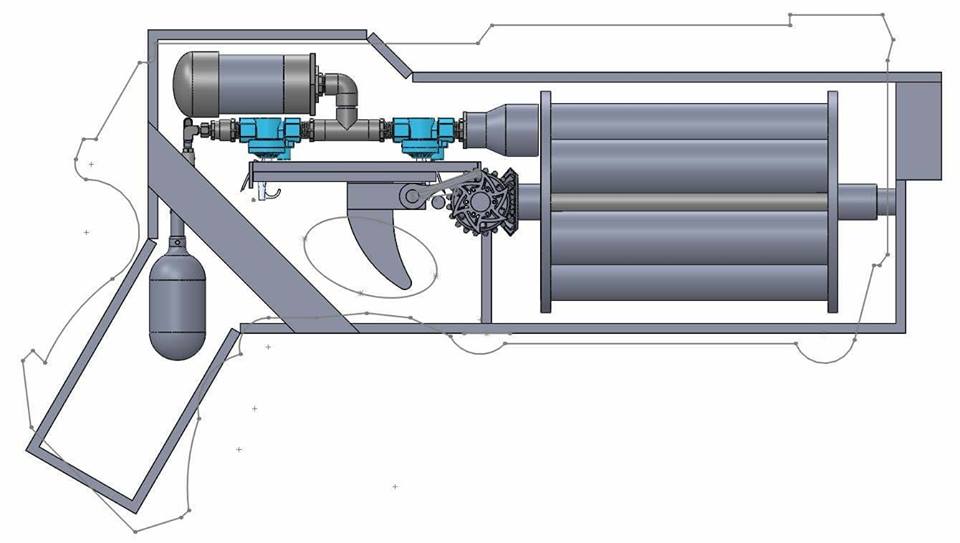Former NASA Engineer Builds Massive NERF Blaster with Help from Eclectical Engineering and a 3D Printer
 Like many children of the 1970s, ’80s and ’90s, I participated in many a NERF battle as a kid. I’ve both won and lost many times, and have taken enemies down – and been taken down – with an arsenal of blasters, bows and arrows, and torpedoes. If I had ever possessed a weapon like former NASA engineer Mark Rober’s, however, I would have been unstoppable, as he now is. Rober, who claims that his coworkers regularly pick on him in workplace NERF wars, decided to build a weapon that would give him the advantage over his opponents.
Like many children of the 1970s, ’80s and ’90s, I participated in many a NERF battle as a kid. I’ve both won and lost many times, and have taken enemies down – and been taken down – with an arsenal of blasters, bows and arrows, and torpedoes. If I had ever possessed a weapon like former NASA engineer Mark Rober’s, however, I would have been unstoppable, as he now is. Rober, who claims that his coworkers regularly pick on him in workplace NERF wars, decided to build a weapon that would give him the advantage over his opponents.
For help, he turned to his friends Ryan and David of Eclectical Engineering. The two specialize in both projectiles and wanton destruction in the name of science, so building the world’s largest NERF gun was right up their alley. With an assortment of tools that included everything from PVC pipe to a paintball tank, they set to work – with some help from a 3D printer, of course.
 The frame of the gigantic blaster was constructed from wooden planks, painted bright yellow to resemble the average-sized NERF handgun they used as a model. While the size alone should have been enough to make any potential enemy take a step back, the blaster’s power came from a hacked paintball tank fitted up with a low pressure regulator and a 3D printed handle. The rest of the gun, including the cylinder and firing chamber, was built from an assortment of parts easily found at any hardware store. (For a full list of materials, check out the project page here.)
The frame of the gigantic blaster was constructed from wooden planks, painted bright yellow to resemble the average-sized NERF handgun they used as a model. While the size alone should have been enough to make any potential enemy take a step back, the blaster’s power came from a hacked paintball tank fitted up with a low pressure regulator and a 3D printed handle. The rest of the gun, including the cylinder and firing chamber, was built from an assortment of parts easily found at any hardware store. (For a full list of materials, check out the project page here.)
Of course, a giant NERF blaster also requires giant projectiles, so the team cleverly utilized pool noodles and plungers, along with 3D printed adapters and blast caps, to create a series of monster darts that, when fired, exited the blaster at 40mph. They also 3D printed some projectiles that, while lacking the ability to stick to targets like the noodle/plunger darts, were much more aerodynamic and thus traveled much further – up to 130 yards.
Needless to say, the gigantic blaster made the original handheld gun look pitiful in comparison.
“The pressurized air source is a 3000 PSI, 62 cubic inch HPA paintball tank. The air from this tank is immediately reduced to 800 PSI by the regulator at the end of the tank, then again to ~80 PSI by a special low pressure regulator,” Eclectical Engineering explains. “This brings the pressure to (somewhat) reasonable values for launching of normal objects at subsonic, non-relativistic speeds. The pressurized air then feeds up to the first sprinkler valve, which is normally closed. When ready to fill the firing chamber, you simply press the air blowgun attached to this sprinkler valve and the pressurized air gladly fills this region. Now to fire the system you press the air blowgun attached to the other sprinkler valve and BAM. You’re instantly the coolest kid on the block…the cell block.”
 So it’s essentially the same kind of pneumatic system that powers a regular NERF blaster – just much bigger. Never satisfied with minimal destruction, however, David and Ryan decided to further adapt the giant blaster by replacing the air system with a black powder cannon. They then took the retrofitted blaster out into the desert to obliterate some watermelons, which you can see below.
So it’s essentially the same kind of pneumatic system that powers a regular NERF blaster – just much bigger. Never satisfied with minimal destruction, however, David and Ryan decided to further adapt the giant blaster by replacing the air system with a black powder cannon. They then took the retrofitted blaster out into the desert to obliterate some watermelons, which you can see below.
While I would think the black powder version of the blaster may fall into the “don’t try this at home” category, you can try building your own giant pneumatic blaster with the full instructions here. Discuss further in the 3D Printed Nerf Gun forum over at 3DPB.com.
Subscribe to Our Email Newsletter
Stay up-to-date on all the latest news from the 3D printing industry and receive information and offers from third party vendors.
Print Services
Upload your 3D Models and get them printed quickly and efficiently.
You May Also Like
Making Space: Stratasys Global Director of Aerospace & Defense Conrad Smith Discusses the Space Supply Chain Council
Of all the many verticals that have been significant additive manufacturing (AM) adopters, few have been more deeply influenced by the incorporation of AM into their workflows than the space...
EOS in India: AM’s Rising Star
EOS is doubling down on India. With a growing base of aerospace startups, new government policies, and a massive engineering workforce, India is quickly becoming one of the most important...
PostProcess CEO on Why the “Dirty Little Secret” of 3D Printing Can’t Be Ignored Anymore
If you’ve ever peeked behind the scenes of a 3D printing lab, you might have caught a glimpse of the post-processing room; maybe it’s messy, maybe hidden behind a mysterious...
Stratasys & Automation Intelligence Open North American Tooling Center in Flint
Stratasys has opened the North American Stratasys Tooling Center (NASTC) in Flint, Michigan, together with automation integrator and software firm Automation Intelligence. Stratasys wants the new center to help reduce...


































